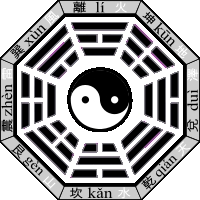|
|
| Chinese
History |
Huang Di
|
|
Three Sovereigns
The era is around 3, 000 BC (Or 5, 000 BC or 7, 000
BC depending upon your sources), and it is a time of
myths and legends. During the earliest times, three
great Sovereigns arose, and these are known as: The
Heavenly Sovereign Fuxi, The Earthly Sovereign Nüwa,
and The Human Sovereign Shennong. Fuxi and Nüwa
are similar to Western Adam and Eve. They are the first
God and Goddess, or first Man and Woman. They appear
as the creators of humankind after a great flood.
Fuxi is attributed with inventing the ‘Bagua’,
which is a foremost concept in basic Taoist thinking,
and also represents Yin and Yang. It is represented
by a very early form of writing which uses three lines
of dots and dashes (Simplified) known as trigrams

Fuxi and Nüwa produce a Son called Shennong, who
is known as the first human being. He creates farming,
invented the plough and fishing, medicine; and also
money and places to exchange goods. This could be said
to represent the dawn of civilisation with people making
villages and living in one place for the first time.
The Five Emperors
References for this period are at best conflicting.
The ‘I Ching’, Songs of Chu, and The Book
of Rites each ascribe different names, or include
the 3 Sovereigns. So let us stick with archaeological
and documented facts.
The Yellow Emperor was called Huang Di ( ),
who was most famous of the Five Emperors. Huang Di,
Yan Di and Chi You were Warlords and controllers of
a large areas of land on the middle reaches of the Yangtze
river. The area corresponds to modern day Henan and
neighbouring Shaanxi Provinces. At this time other cultures
were also flourishing to the north along The Yellow
River. Huang Di and Yan Di were related, whilst Chi
You was a Southern invader. ),
who was most famous of the Five Emperors. Huang Di,
Yan Di and Chi You were Warlords and controllers of
a large areas of land on the middle reaches of the Yangtze
river. The area corresponds to modern day Henan and
neighbouring Shaanxi Provinces. At this time other cultures
were also flourishing to the north along The Yellow
River. Huang Di and Yan Di were related, whilst Chi
You was a Southern invader.
There was a three-way war for control going on, with
some texts saying that Huang Di first defeated Yan Di,
and then Chi You; whilst the more popular comment is
that Huang Di, Yan Di, and all the other tribes banded
together to defeat Chi You, then had a war amongst themselves.
Recent archaeology tends to support the former theory
and evidence concerning the main battle is also being
corroborated. For instance, the site of the battle is
now fixed, and it is known that Huang Di used local
knowledge of sudden local fog to outwit Chi You. However
it was his invention of the 'South Pointing Chariot'
that secured his edge in this battle.
The South pointing Chariot was a real device, and a
vehicle with a non-magnetic indicator on top that always
points south. We presume this to be some form of mechanical
contraption that was first set to true south before
battle commenced. The actual plans were known to exist,
but were destroyed millennia later by zealous warlords
seeking to protect themselves from possible dangers.
Therefore we do not actually know how the chariot worked,
but documentation of the design's destruction suggest
it existed. Given the battle took place in severe fog,
this chariot enabled Huang Di to control his troops
to great effect. The battle ground was actually a plain
bounded by a river to one side, and ringed by mountains
on the other three sides. Militarists may quickly deduce
the importance of knowing which way south is, which
is your adversaries homeland, to be highly significant
- especially for a battle waged within a large but yet
confined space.
Whichever theory you subscribe to, the fact remains
that of the three Kings, Huangdi won, and became the
first leader of a united China. However, he is not the
first Emperor of China, as that comes several millennia
later.
Ancient Empires
Huangdi is known
as the forefather of the Han Chinese, and most Chinese
today trace their cultural roots back to him. They
will also refer to this as the Yue or Yu Dynasty,
and I only have verbal street talk to support this
at time of writing. Do not confuse this as being the
same as the peoples of Yue when used in a different
way – such as the contemporary Yue Tribes of
Southern China of that era, the Yue Kingdom of Northern
ZheJiang during the Warring States Period; or the
modern term for Cantonese people, which is also Yue.
These are all different, but are written in English
in the same way.
Huangdi is commonly regarded as the very first leader
of modern China, and dates for his life vary between
5, 000 and 7, 000 years ago. This will be confirmed
via carbon dating in due course. Indications are that
the earlier date is in fact correct!
Huang Di is said to have had high moral status, and
is regarded as the creator of Kung Fu, medicine, and
music. He is also attributed status as a Taoist deity.
His wife created silk by nurturing silkworms, and spinning
their threads.
Factfile:
1. Ancient legends are now being shown to
be based largely in real facts
2. First Man and Woman - Fuxi and
Nüwa produce a Son called Shennong
3. Creation Myth
4. After The Deluge Myth
5. Dragon Cultures
6. Farming, settlements, and pre-dawn
of civilization
7. First forms of written characters
(Taoist), Bagua
8. Simple pottery
9. 2, 500 BC: Cowry shells used as
currency, supplementing the Barter system
a) This indicates International Trade,
as Cowries were also used in India, Africa, and The
Middle East during contemporaneous periods
10. Huang Di – The Yellow Emperor,
formed the first Han Chinese Kingdom (Same English spelling,
different Chinese characters).
Reference Point:
Huang Di – The Yellow Emperor |
|
This
information is as supplied by Wikipedia, as dated March
2009 or later, and/or other reliable sources.
Maps (Unless stated otherwise)
are provided in association with Thomas Lessman
Web: www.worldhistorymaps.info
Disclaimer:
Please check this information yourself as it may alter
without notice, and whilst we try our best to ensure
it is correct, please do not hold us responsible for
any errors - this is intended as a simple guide only |
|
| Search
this Website |
|
|
| Our
Friends |
Excellent
& Free Online Chinese Language Portal

Thousands of free print-friendly Chinese reference sheets,
tests and revision aids.
Easy Learning format &
Listen to Spoken Words |

Professional
Visa Services
Company
Formation Packages
.
|

British Foreign Office
Resource and Advice for Travellers Worldwide |

Chinese Embassy in UK
Information About China
International Relations
Visa & Consular |

UK Embassy in China
Information About UK
International Relations
Visa & Consular |

|
Excel
Education |
Languages Courses
Study Abroad
Employability
Summer Camps
Information for Teachers |
|

Excellent and relaxing base to
explore this most beautiful of regions in all China! |
Down The Road.org
How We Traded Our Ordinary Lives For a Global Bicycle Touring Adventure

See
Us in China |

Empowering Underprivileged Children
& Their Communities = Worldwide |
 |

Based in Shangri-la,
Yunnan
Province
Dedicated to Exploring Remote Areas of China
Committed to Nature Conservation and Preserving Ethnic
Cultures & Traditions
|

Based in Xi'an,
China's Premiere Travel Agency and International Travel
Community -
Committed to providing:
Best travel deals & current information for all
International Travellers |

Pearl Dragon |
|